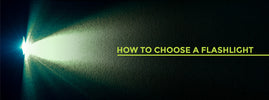
How to Choose a Flashlight
, by Chas Waters, 8 min reading time

, by Chas Waters, 8 min reading time
Flashlights are handy tools when you need a handheld light source that produces a strong beam. They are also great when you want to control the light and have the freedom to set it down as you work on a task. The invention of portable, brighter and more energy-efficient flashlights makes them desirable for people looking for a lighting solution for home, work and outdoor applications.
There are various factors and features to look for when buying a flashlight. Below, we discuss some of these factors and highlight how they affect your choice of a flashlight.
Light output is the most important feature when choosing the right flashlight. It refers to the amount of light your flashlight produces on its highest brightness setting when powered by new batteries. The light output for modern-day LED flashlights is measured in lumens, which typically vary between 20 and 3,500 lumens.
Generally, the more lumens on your flashlight, the brighter it will be. The exact brightness or lumens you need depends on how you'll use your flashlight. Here's a quick guide to help you choose the right flashlight when guided by lumens and application:
A light beam's pattern, adjustability and distance are more features you must consider when choosing a flashlight. The beam distance is the range your flashlight can illuminate with full-moon brightness. It's determined by the brightness of the bulb and the reflector. The shape of the reflector also determines the beam intensity and pattern of the light beam.
There are three common beam types you'll encounter when shopping for a good flashlight:
The battery type of your flashlight determines its longevity, while the battery's energy capacity determines the run time — the amount of time your flashlight takes to drain to 10%. Your run time is also affected by the power draw setting, which increases as you move up from low to medium and high light modes. Lower lumens and more batteries in a flashlight can also give you a higher run time.
There are different types of batteries you find in flashlights today. Some of the major categories you'll come across when exploring your flashlight options include:
There are two main types of bulbs used in flashlights. Incandescent bulbs are outdated due to numerous drawbacks, including consuming a lot of energy and having a short life span. Light-emitting diode (LED) bulbs are now more common thanks to their long-lasting battery power and exceptional energy efficiency. They can last up to 100,000 hours on very little power without periodic replacement.
Flashlights with LED bulbs are often smaller, lighter and brighter than incandescent bulbs. They may be more expensive upfront, but you save money in the long term. The cost savings result from LED flashlights requiring fewer batteries that last much longer — up to seven hours on high light mode and 50 hours when on low. They boast low energy consumption, which also reduces your carbon footprint.
Panther Vision has a great selection of LED flashlights with a unique flat or “UNROUND” design. FLATEYE™ Flashlights are available in various lumen options ranging from 100 lumens to 2,175 lumens, therefore being ideal for a variety of tasks, including work and hobbies. They're available in rechargeable and non-rechargeable models and have an ergonomic grip. Check out the revolutionary FLATEYE™ flashlights:
Apart from the above features, a few other details are crucial in helping you choose the best flashlight. Some of these include:
Panther Vision is a leading manufacturer of portable lighting solutions for your work, household and outdoor needs. We have a collection of LED flashlights with a rating of up to 1,200 lumens that illuminate the darkest environments for hours before a battery change or charge is necessary. Our flashlights are made using the finest recyclable, waterproof and impact-resistant materials to extend their battery life.
Browse our collection of LED flashlights and accessories and accessories that improve usability. Contact us to learn more about our products and how we can meet your needs.